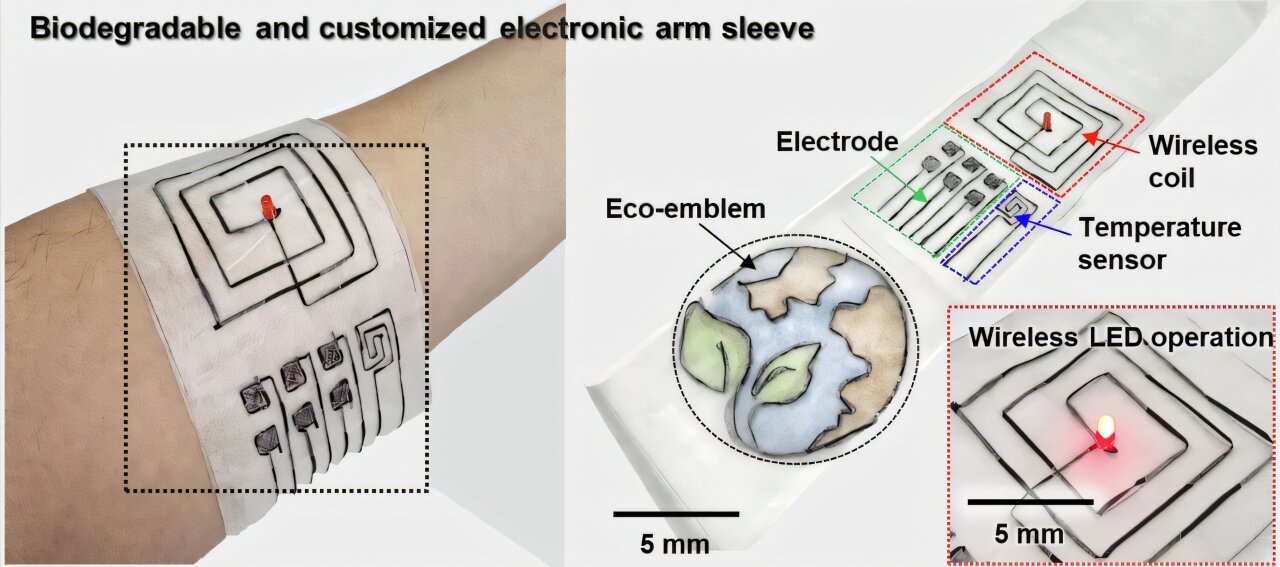
A photograph of the biodegradable electronic Arm Sleeve. The biodegradable Electronic Arm Sleeve Consistent of Wireless Coil, Electrodes, Temperature Sensor and Eco-Mblem. Credit: npj flexible electronics (2025). Doi: 10.1038/s41528-025-00448-x
The World Productions Over 92 Million Tons of Textile Waste Annually, MUCH of It Made from Synthetic Materials that Can Linger for Centuries. Add to that surge in wearable electronics-Smartwatches, fitness trackers, sensor-laden garments –nd the problem builds two-fold.
These e-textiles don’t just include fabric, but also metal wires, plastic substrates, adhesives, and circuits that are nearly impossible to recycle. As Electronics Backet more Intimate, Wearable, and Disposable, The Question Backcomes Urgent: How do we do we design them to disappear when they’re no longer needed?
A research team at Seoul National University has taken a significant step toward answering that question.
LED by Professor Seung-Kyun Kang and Dr. Jae-Young Bae, The Team Has Developed A Fully Biodegradable, High-Performance Conductive Fiber that Can Be Seamlessly Integrated into WeArable Electronics and Naturally Decomde AFter Use. The study was Published in npj flexible electronics,
Unlike Conventional E-Textiles that Persist in Landfills, This New Fiber System MainTains Performance during Use Use But Vanishes in Enzyme-Ric or SOIL Environments, Leaveing Noover Residuency Beendi.
The team’s innovation lies in combining tungsten microparticles with a biodegradable polymer know as poly This core is coated with a flexible, water-adjustant polyanhydride (PBTPA) Layer that enhances mechanical stability with compromising biodegradability.

Mass-produced biodegradable fiber electrodes. Credit: npj flexible electronics
The fiber achieves an impressive electrical conductivity of approximately 2,500 s/m, stretches up to 38% without failure, and endures over 20 laundry cycles and 5,000 bending events- Metrics comparable to or better than many existing e-textile solutions.
Crucially, the fiber is compatible with dry-jet wet-spinning, a scalable process that enabled the team to produce lenseds excaseding 10 meters in a continguous run.
To validate its real-will apply, the fiber was integrated into a weerable smart sleeve featuring a temperature sensor, electromyography (emg) Electrodes, and a wireless poetry coil. The device operated reliably under dynamic movement and environmental stress.
After use, the entry system-including the embroidered eco-com-began to decompes when expected to Soil or Enzymes, Fully disintegrating within a less.
“This is more than just a new material – a platform for sustainable electronics,” said professor kang. “We’ve shown that you can have high-faunction wearable devices that Don’t e-waste after their useful life ends.”

Degradation of biodegradable fiber-based eco-com. Credit: npj flexible electronics
Dr. Bae Added, “The ability to design electronics that match the Lifecycle of the application –nd then gracely disapple disappear -openers up new posesibilites in medicine, SMART UNFORMS, SMART UNFORMS, Enlarce And beyond.
The Research Represents a Rare Confluence of Biodegradability, Mechanical Performance, and Mass-Manufacturaability. Looking ahead, the team aims to expand the platform to incorporate fiber-based memory and logic components, moving towed full integrated, transient electronic systems.
They are also exploring “triggerable” degradation mechanisms that respond to light, heat, or pH -enabling programspans for future devices.
More information:
Yong-Wu Kim Et Al, Fully Biodegradable and Mass-Producible Conductive Fiber Based on Tungsten- Poly npj flexible electronics (2025). Doi: 10.1038/s41528-025-00448-x
Citation: Disappalening Electronics: Biodegradable Fiber Electronics Offer Solution to e-Waste and Textile Pollution (2025, July 14) Retrieved 14 July 2025 from https://techxplore.com/news/2025-07-ectronics- biodegradable-fiber-solution-extile.html
This document is Subject to copyright. Apart from any Fair Dealing for the purpose of private study or research, no part may be reproduced without the written permission. The content is provided for information purposes only.



